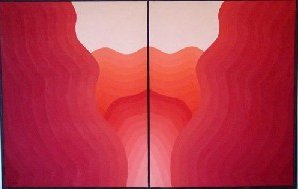Xose Telmo Lodeiro
dal 13/12/2007 al 1/2/2008
Segnalato da
13/12/2007
Xose Telmo Lodeiro
Centro Galego de Arte Contemporanea CGAC, Santiago de Compostela
As a painter he hoped to achieve the harmony between art and the world, by means of feeling and of the symbolic power of forms, mostly through landscapes, but without rejecting the expressive strength of the human form, combining the two on numerous occasions.

Xosé Telmo Lodeiro (Vigo, Spain, 1930-1996), without the insignias of belonging to any style or school, exemplifies the individual artist’s finding of his place within the community that he interprets. His pictorial work, which defined one of the pinnacles of Galician art in the second half of the twentieth century, cannot be understood without the social, geographical and human clamour found in essentially romantic artists.
In his public life, he was an activist, insocial, political and other spheres, who took part in any collective projects aimed at bringing art and life together, to popularise and socialise art. He took part in the proposals of the Estampa Popular, and in the outdoor shows of the Praza da Princesa, and was a member of the Atlántica group in the eighties.
As a painter he hoped to achieve the harmony between art and the world, by means of feeling and of the symbolic power of forms, mostly through landscapes, but without rejecting the expressive strength of the human form, combining the two on numerous occasions. With most of his work, itis worth noting a technical- procedural feature. Lodeiro painted on canvas by mixing his oil paints with ground stone, Pedramol, which results in painstaking preparation of the paste with its shades of uniform colours, and also in the slow application of the pigments on the canvas.
Lodeiro used to work long hours in his studio, in a way which was somewhat similar toan industrial assembly line. This working pace, in terms of the reasons which produced it, goes well beyond mere technical issues, and the slowness in obtaining textures, to the extent that it can even provide a partial explanation of his formal creation processand of the definition of his iconographic repertoire: the symbolic use of light and the technique used for the application of each colour, ordered by tonal range. His light is always tenacious.
Following his early activity,which was linked to super- realism, the artist’s intuitive cascade soon entered a process of decanting, of a deep iconisation of his repertoire, activating a pure vision and setting limits to the overcoming of the subjective. Individual freedom thrived, and grew very much in line with European abstractionist proposals from earlier decades before, paths which would lead him to practice geometric and optical abstraction formany years, in an exploration of the geometric roots of kinetics.
Obsessive fantasies never quite disappeared from his work, but they became so submerged in a specific work process that it is pointless to establish links with the surrealist technique of automatisms and coincidences.
His painting was subject to intelligence and to systematic rigour. Nothing could be further from improvisation than a piece by Lodeiro.
His landscapes, which are characterised by their expansive arrangement of colours and the splitting of perspective by means of tonal gradation,a lways had as their main point of reference the geography of Lodeiro’s birth place,Vigo (he used to sign his paintings ‘painter from Vigo’). In these works, Lodeiro
makes recurring use of minimal elements in asequential evolution, which takes them from the peripheral darkness to the central focus of light.
Lodeiro was less a theoretician than an individual who was reluctant to speak indepth about his work, but, whether intuitively or with greater conviction than we are aware of, in his paintings he tackles the ideological infection which ailed a lot of the pictorial work of the time –a cry, therefore, against painting-fiction.
By the time he was awarded the Critic’s Prizein 1994 and retrospective exhibitions of his work were being held, Lodeiro had already seen it all before. He had been painting with a paintbrush since 1990, flat and pure oils on the canvas, electrified and stunning. His last series combined the frenzy of psychedelic order with a personal and deliberate version of pop art. As his final legacy, he left an enigma: the flower paintings which X. L. Méndez Ferrín called ‘the flowers of evil’. This exhibition recounts every one of Lodeiro’sa dventures.
Alberto González-Alegre, Román Pereiro Alonso
Press conference: 14 December, 12h / Opening: 20h
Centro Galego de Arte Contemporanea
Rua Valle Inclan s/n 15704 - Santiago de Compostela
Hours: Tuesday – Sunday: 11:00-20:00. Monday: Closed.



